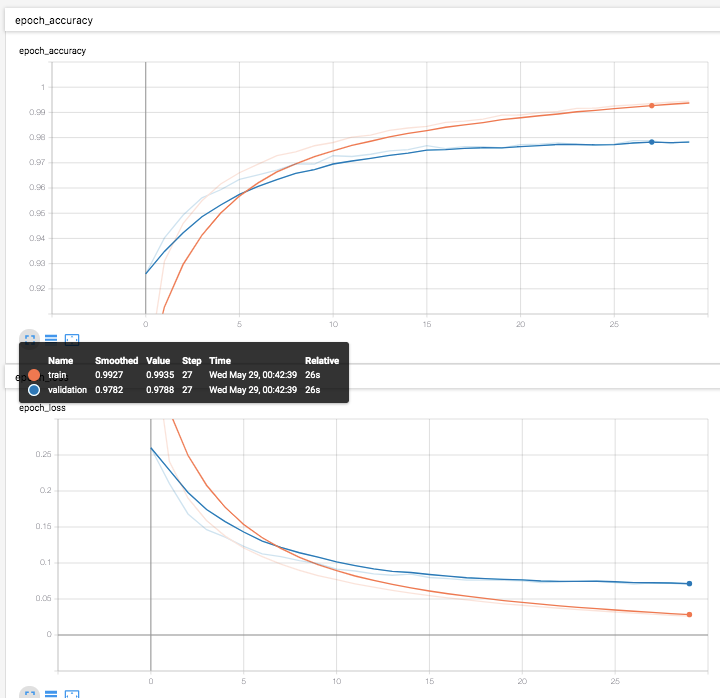(目次はこちら)
はじめに
多層パーセプトロン [TensorFlowでDeep Learning 3]をtensorflow2.0で実現するためにはどうしたらいいのかを書く(tf.keras)。
コード
Python: 3.6.8, Tensorflow: 2.0.0a0で動作確認済み
多層パーセプトロン [TensorFlowでDeep Learning 3] (mnist_softmax_fc.py)を書き換えると、
v2/mnist_softmax_fc.py
from helper import *
IMAGE_SIZE = 28 * 28
CATEGORY_NUM = 10
LEARNING_RATE = 0.1
FEATURE_DIM = 100
EPOCHS = 30
BATCH_SIZE = 100
LOG_DIR = 'log_softmax_fc'
EPS = 1e-10
def loss_fn(y_true, y):
y = tf.clip_by_value(y, EPS, 1.0)
return -tf.reduce_sum(y_true * tf.math.log(y), axis=1)
class Dense(tf.keras.layers.Layer):
def __init__(self, units, activation, *args, **kwargs):
super().__init__(*args, **kwargs)
self.units = units
self.activation = tf.keras.activations.get(activation)
def build(self, input_shape):
input_dim = int(input_shape[-1])
self.W = self.add_weight(
name='weight',
shape=(input_dim, self.units),
initializer=tf.keras.initializers.GlorotUniform()
)
self.b = self.add_weight(
name='bias',
shape=(self.units,),
initializer=tf.keras.initializers.Zeros()
)
self.built = True
def call(self, x):
if self.activation is None:
raise Exception('Activation function is None')
return self.activation(tf.matmul(x, self.W) + self.b)
if __name__ == '__main__':
(X_train, y_train), (X_test, y_test) = mnist_samples(flatten_image=True)
model = tf.keras.models.Sequential()
model.add(Dense(FEATURE_DIM, input_shape=(IMAGE_SIZE,), activation='relu'))
model.add(Dense(CATEGORY_NUM, input_shape=(FEATURE_DIM,), activation='softmax'))
model.compile(loss=loss_fn, optimizer=tf.keras.optimizers.SGD(LEARNING_RATE), metrics=['accuracy'])
cb = [tf.keras.callbacks.TensorBoard(log_dir=LOG_DIR)]
model.fit(X_train, y_train, batch_size=BATCH_SIZE, epochs=EPOCHS, callbacks=cb, validation_data=(X_test, y_test))
print(model.evaluate(X_test, y_test))
と書ける。結局2つの層は活性化関数が異なるだけなのでそれを引数として渡せるように変更。
で、この、Denseクラスは、tf.keras.layers.Dense(tensorflow/python/keras/layers/core.py)とほぼ同じものなので、
わざわざ定義する必要は全くなく、シンプルに書ける。
v2/mnist_softmax_fc_simple.py
from helper import *
IMAGE_SIZE = 28 * 28
CATEGORY_NUM = 10
LEARNING_RATE = 0.1
FEATURE_DIM = 100
EPOCHS = 30
BATCH_SIZE = 100
LOG_DIR = 'log_softmax_fc'
EPS = 1e-10
if __name__ == '__main__':
(X_train, y_train), (X_test, y_test) = mnist_samples(flatten_image=True)
model = tf.keras.models.Sequential()
model.add(tf.keras.layers.Dense(FEATURE_DIM, input_shape=(IMAGE_SIZE,), activation='relu'))
model.add(tf.keras.layers.Dense(CATEGORY_NUM, input_shape=(FEATURE_DIM,), activation='softmax'))
model.compile(
loss='categorical_crossentropy',
optimizer=tf.keras.optimizers.SGD(LEARNING_RATE), metrics=['accuracy'])
cb = [tf.keras.callbacks.TensorBoard(log_dir=LOG_DIR)]
model.fit(X_train, y_train, batch_size=BATCH_SIZE, epochs=EPOCHS, callbacks=cb, validation_data=(X_test, y_test))
print(model.evaluate(X_test, y_test))
